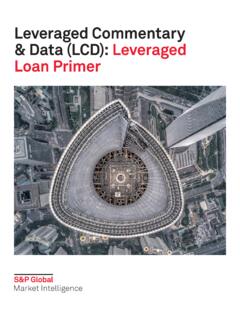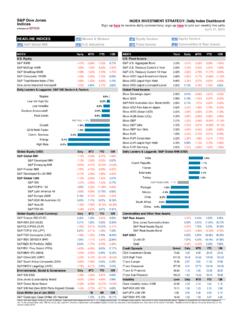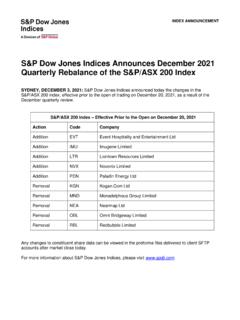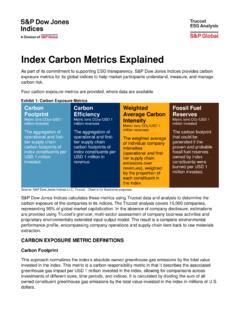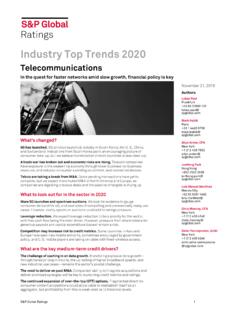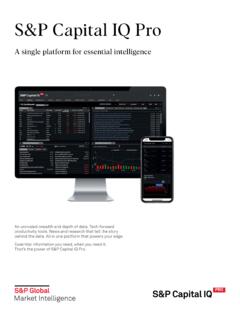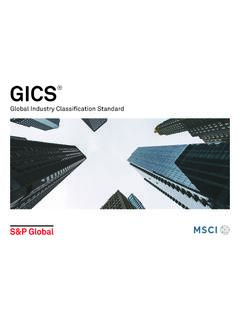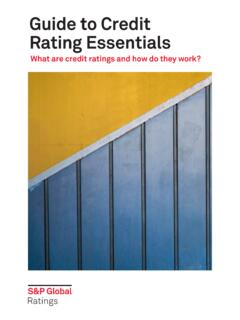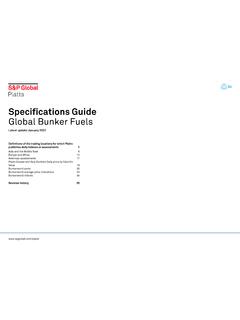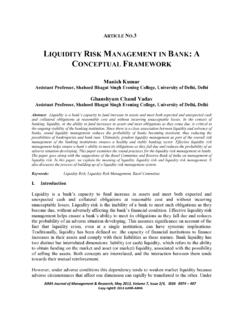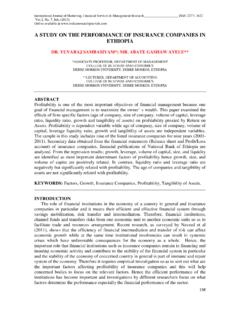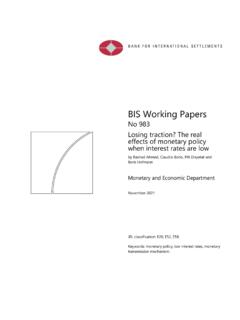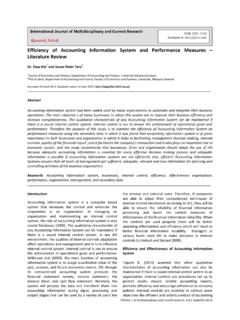Transcription of 5 Key Credit Risk Factors to Consider When Assessing ...
1 1 5 Key Credit Risk Factors to Consider when Assessing Alternative Exposures By Edward McKeon, Director, Credit Risk Solutions, S&P Global Market Intelligence Yoshihide Miyamoto, Associate Director, Credit Risk Solutions, S&P Global Market Intelligence August 2019 Overview In our recent webinar, 5 Key Credit Risk Factors to Consider when Assessing Alternative Exposures, we focused on non-bank financial institutions (NBFIs), small and medium enterprises (SMEs), and investment holding companies (IHCs). This article provides a summary of the webinar, describing the S&P Global Market Intelligence ( Market Intelligence ) analytical frameworks for Assessing Credit risk in these three areas, providing a checklist to help support consistent analyses, and concluding with a section on frequently asked questions.
2 It should be noted that NBFI scores and Stand-Alone Credit Profile (SACP) scores1 mentioned in this article are S&P Global Ratings Scores and Factors , which are different than the Credit scores produced by Market The S&P Global Ratings scores are inputs used to calculate a Credit rating, whereas a Credit score is the final assessment of creditworthiness. 1 SACPs refer to S&P Global Ratings' opinion of an issue's or issuer's creditworthiness, in the absence of extraordinary intervention from its parent or affiliate or related government, and are but one component of a rating. 2 S&P Global Ratings does not contribute to or participate in the creation of Credit scores generated by S&P Global Market Intelligence. Lowercase nomenclature is used to differentiate S&P Global Market Intelligence scores from the Credit ratings issued by S&P Global Ratings.
3 CONTACT US Asia-Pacific +852-2533-3565 Europe, Middle East & Africa +44-207-176-1234 The Americas +1 877 863 1306 5 Key Credit Risk Factors to Consider when Assessing Alternative Exposures Copyright 2019 by S&P Global Market Intelligence, a division of S&P Global Inc. All rights reserved 2 A Look at NBFIs NBFIs include financial institutions typically not registered as banks that make loans to individuals and businesses. The Market Intelligence analytical framework for global NBFIs, described below, leverages the S&P Global Ratings Banking Industry and Country Risk Assessment (BICRA) methodology. BICRA comprises an economic risk score and an industry risk score. The economic risk score focuses on economic resilience, imbalances, and overall Credit risk where the financial institution has operations.
4 The industry risk score is centered on the institutional framework, competitive dynamics, and system-wide funding of the financial institution where it is domiciled. Combined, these scores are then used to determine a preliminary anchor, which acts as a starting point for determining the SACP for an NBFI. This essentially represents the baseline creditworthiness of banks operating in that market. The preliminary anchor for NBFIs expresses both the general level of risk for the banking sector, as well as the additional risks levelled at non-banking participants. After considering macro Factors , the framework focuses on an entity-specific assessment. Four broad risk dimensions are analysed for this: business position; capital, leverage, and earnings; risk position; and, funding and liquidity.
5 These Factors differentiate NBFIs either positively or negatively from their competitors. From an application perspective, if the anchor score (derived then adjusted from the BICRA) is a bb+ and the four risk dimensions are neutral, the SACP score remains bb+ . However, if a NBFI has a weak business position resulting in a score of -1 (a one-notch reduction), and the other risk Factors are neutral, the SACP score is bb . Additional adjustments can also be made to account for group and government support to determine a final score. 5 Key Credit Risk Factors to Consider when Assessing Alternative Exposures Copyright 2019 by S&P Global Market Intelligence, a division of S&P Global Inc. All rights reserved 3 5 Key Drivers of Credit Risk for NBFIs 1.
6 Non-Bank Industry and Country Risk Assessment. NBFIs face incremental risks relative to banks since they lack access to a central bank, which increases liquidity and funding risk. They also face strong competition from banks due to the lower cost of financing and lower barriers to entry for banks within the NBFI segment during more volatile or fragmented business conditions. In addition, NBFIs usually lack the regulatory oversight that banks have, heightening their sensitivity to changes in investor confidence. These risks typically lead to an anchor for an NBFI that is lower than that for a bank operating in the same jurisdiction. 2. Business Diversity and Stability. Business stability considers the predictability of continuing business volumes in the face of potential economic and market fluctuations.
7 Specifically, we look at the business mix, revenue stability, and market position contribution of revenues generated and the resulting impact on business position. Business diversity, on the other hand, considers business line revenue diversification, geographic and industry diversification, and customer revenue concentrations. 3. Capital and profitability . Capital and profitability measures a NBFI s ability to absorb losses. The analysis takes into account the quantity and quality of the capital base, as well as the entity s earnings capacity. 4. Lending and Underwriting Standards. Similar to the anchor analysis, the lending and underwriting standards for a bank in any given country are analysed before comparing that NBFI s lending and underwriting standards with what is expected in the operating environment.
8 Key metrics at the NBFI are then reviewed, taking into account the type of lending it does. For example, household lending focuses on loan-to-value (LTV) ratios, whereas corporate lending looks into the sector concentration in cyclical or vulnerable sectors, such as real estate, construction, commodities, and shipping. 5. Funding and Liquidity. This risk dimension assesses a NBFI's capacity to support business performance through effective funding, while managing liquidity requirements both on an ongoing basis and in periods of stress. A Look at SMEs The analytical framework for SMEs follows the corporate assessment criteria, where the combination of business risk and financial risk determines the entity s anchor score. The assessment of business and financial risk is based on an analysis of several Credit risk Factors .
9 The anchor score is then adjusted upwards or downwards based on Credit risk modifiers that measure management and governance, as well as liquidity and financial flexibility. Once the SACP of the entity is derived, it is possible to factor in any explicit external support that might come from a group or government, similar to the approach in the NBFI framework. 5 Key Credit Risk Factors to Consider when Assessing Alternative Exposures Copyright 2019 by S&P Global Market Intelligence, a division of S&P Global Inc. All rights reserved 4 5 Key Drivers of Credit Risk for SMEs 1. Customer and Supplier Relationships. Dependencies on particular customers and suppliers can hamper a SMEs competitive advantage. Additional consideration should also be given to long-term relationships with those customers and suppliers that may impact growth and timely payments, as well as any bargaining power for favorable trading terms.
10 2. profitability . This considers the level of profitability based on the respective industry and market averages in certain countries, as well as the volatility of profitability over a number of years. 3. Liquidity and Financial Flexibility. Since many SMEs often rely on informal sources of capital, it is important to assess both their financing needs, plans, and alternatives, as well as their flexibility to accomplish their financing program under stress without damaging creditworthiness. when looking at external funding capability to complement internal cash flow in emerging markets, the focus should be mostly on the SME s relationships with banks and the availability of bank lines of Credit . 4. Management Quality, Depth, and Continuity.
